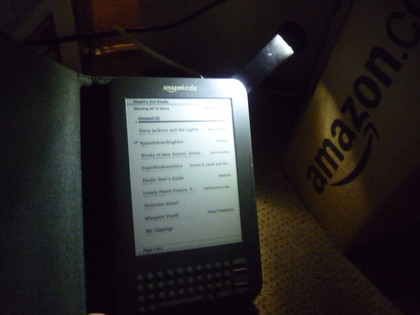Why you can trust TechRadar

There are a number of ways to get books onto the new Kindle 3. The most obvious is to buy them from the Kindle store, which is now a dedicated UK operation.
Kindle definitely has the edge over Apple's rival iBook Store in both pricing and range, but both still have some way to go.
If you're expecting eBooks to offer major savings over paper, you may be disappointed. Typical savings on paperbacks are a few pence, although new release hardbacks are better – the new Terry Pratchett for example is £3.64 cheaper on Kindle than Amazon proper, but his most recent paperback release is only a 20p saving.

The case is an option extra
Apple's store doesn't have any Pratchett books at all.
Downloading a book takes a few seconds over 3G or wi-fi, not much longer with GPRS, and you can read your Kindle-bought books on your PC or Mac, on an iPhone, iPad or an Android device as well as the Kindle itself.
It even syncs up your latest reading position so if you don't have your Kindle on you, you can read a few pages on your HTC Desire and on getting home your Kindle will have moved on to the right place.
Sign up for breaking news, reviews, opinion, top tech deals, and more.
Alternatively, if you have documents in one of the eBook formats, you can either load them directly via the Kindle's USB connection (it appears on your PC or Mac like a memory card) or if required convert them to a supported format using 3rd party software like Calibre.
You can load PDF documents into the Kindle too. There's also a system for converting Word documents – you e-mail the documents to a special address and the docs are converted and uploaded to your Kindle automatically; there is a small fee for that.
Wi-Fi or 3G version?
We've reviewed the 3G version here, but unless your planning is so poor, or your reading so fast, that you find yourself caught short of a book to read between leaving the house and arriving at work, we'd question whether it was worth the £40 extra over the Wi-Fi only edition.
Naturally you can change the font and text size (if the book lets you; some have their own embedded fonts), and you can switch to a sideways orientation if you like.

The optional case has a light for reading in the dark
The Kindle has a text-to-speech function, but we wouldn't recommend it as it trips up over sentence endings. Margin scribblers will be happy with the ability to add highlights and notes – and even share them over the usual social networks.
You can view the most highlighted parts of the book you are reading, should the fancy take you - the 21st Century version of looking for the most thumbed sections of a James Herbert novel.
In use, the reading experience is flawless. The display is of course a passive one, so no reading in the dark (unless you buy the £50 case with a built in reading light), but it's much easier on the eyes so you won't get an "iPad migraine".
It should be great in direct sunshine too, although the British weather prevented a scientific test of that. It's matt screen certainly prevents annoying reflections. Long term reading on the Kindle is a joy.
Interface
Away from reading, the device's monomania does have a knock on effect on its usability.
Selecting a book and navigating the device's menus is done with a square four-way selector with a central OK button, along with dedicated Home, Menu and Back buttons.
It works, but it feels very old fashioned and clunky. That's not helped by the monochrome display's inability to highlight options – you have to look for the underline.
There is a QWERTY keyboard with tiny buttons and an awkward Shift key. It will get very little use for most people, and we wonder if the area at the bottom could have been better used for a more sophisticated menu control system.
The little extras
Probably stung by the multi-function loveliness of the iPad, Amazon has added some extra features to the Kindle 3, labelling them "Experimental" in the hope we won't be too harsh about them.
There is a web browser; it's based on WebKit so is compatible with most sites but as you can imagine browsing on a 16-greyscale 800 x 600 display which can't cope with animation and no touchpad is not anyone's idea of a nice experience.
You could use it in emergencies. It does have a nice Article View, which strips out all but the body text of a page and presents as straight text, making the most of the Kindle's advantages, but unfortunately you still have to use the normal view to navigate to the page you want to read.
The new Kindle also allows playback of MP3s while you read. That could be a very nice feature, but as the only controls are pause and skip forward, there's no track selector or even an indicator of what's playing, you'd have to say it's not really usable.
Remarkably the thing they could so easily have added to a device with a network connection, a great screen for text and a QWERTY keyboard – e-mail – isn't there even as an experimental feature.
